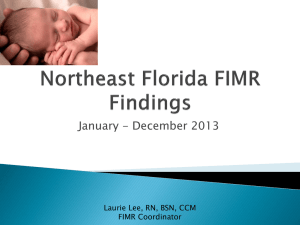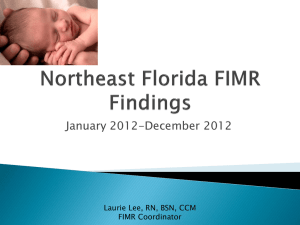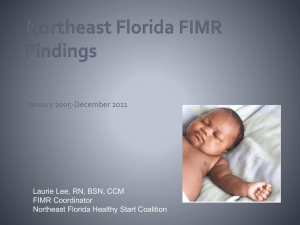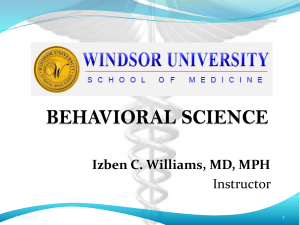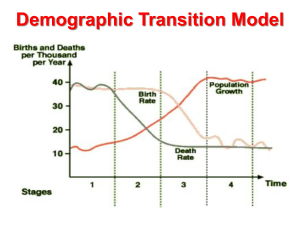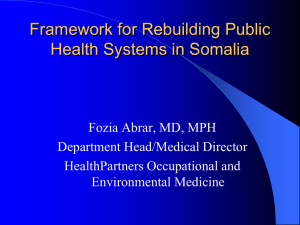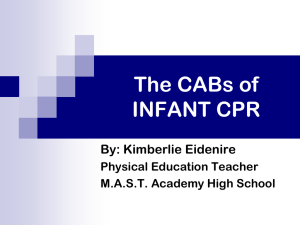Basic Track Workshop C: Abstracting Medical Records
advertisement
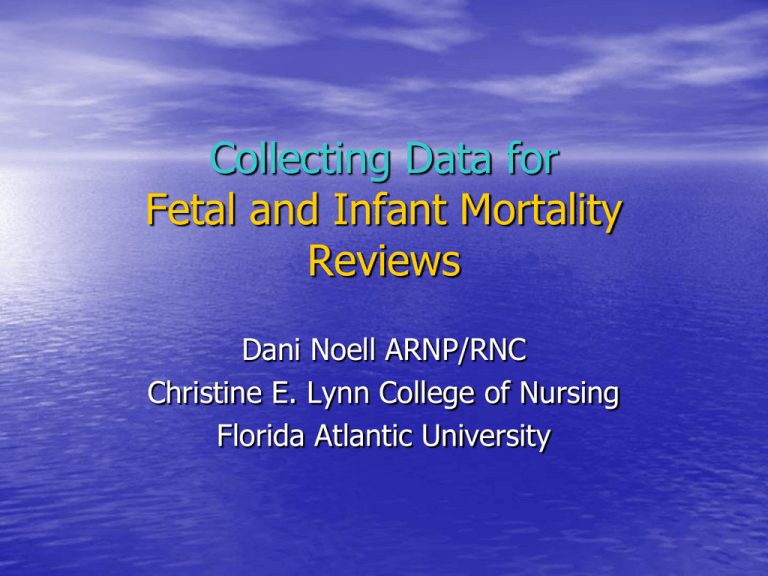
Collecting Data for Fetal and Infant Mortality Reviews Dani Noell ARNP/RNC Christine E. Lynn College of Nursing Florida Atlantic University Program Description Collecting Data for Fetal and Infant Mortality Reviews (FIMR) was developed as a final graduate project for the masters degree of nursing at Christine E. Lynn College of Nursing, Florida Atlantic University, Boca Raton, Florida by Danielle Noell, ARNP/RNC, under the direction of Marilyn Parker, PhD, RN, FAAN, Project Advisor and Kathleen Buckley, CNM/MSN, Project Chair. Dani Noell is a neonatal nurse practitioner with over a decade of experiences abstracting records for fetal, infant, child and maternal mortality review projects. She has been a nurse for 30 years and believes very strongly in the Fetal and Infant Mortality Review (FIMR) process as a way to improve systems of care for communities. Ms. Noell has abstracted hundreds of cases, provided training to FIMR data abstractors in Florida, presented at national FIMR conferences regarding data abstraction and has traveled to several states to provide data abstraction training to new FIMR projects. Ms. Noell wrote the chapter on data abstraction in the National Fetal and Infant Mortality Review Manual (NFIMR): A Guide for Communities and was a coauthor for FIMR: A Guide for Home Interviewers. Fetal and Infant Mortality Review Fetal and Infant and Mortality Review (FIMR) projects are community based efforts to learn more about the factors and issues associated with fetal and infant deaths and to make recommendations and take action to improve system of care. The National Fetal and Infant Mortality Review Program (NFIMR) is a collaborative effort between the American College of Obstetricians and Gynecologists and the Maternal and Child Health Bureau, Health Resources and Service Administration. Beginning in the 1980’s with under 10 projects, today there are over 200 nationwide, with more starting each year. There is also international interest in starting these review projects. Who is this training for? This training is for beginning FIMR abstractors and project coordinators who are interested in learning more about how data is collected for the FIMR review process. Objectives By the end of this presentation the learner will be able to: • Discuss ways to organize abstraction materials • Describe methods to access data sources • Discuss barriers to abstraction • Recall importance maintaining confidentiality protocols • Identify method to summarize case. • Discuss role of abstractor caring for self. Introductions Entering the Project Resources • National Fetal and Infant Mortality Review Program • Materials: publications, technical assistance, electronic resources • FIMR Projects: about 200 in local and state levels • Email: nfimr@acog.org FIMR Process Definitions • Fetal death: a death prior to delivery if the 20th week of gestation has been reached and fetus does not breathe or show any other evidence of life such as beating of the heart, pulsation of the umbilical cord, or definite movement of voluntary muscles. • Infant death: any death of an infant from birth up to (but not including) one year of age. • Neonatal: death of a live born infant before 28 days of life. • Post neonatal: death of an infant after 28th day up to (but not including) one year of age. FIMR Data • Vital statistics • Maternal interviews • Medical records • Social services Vital Statistics STRENGTHS WEAKNESS • Traditional/well • Limitations established • Accuracy • Availability • Community specific/ Population based data • Helps with FIMR focus Medical Records STRENGTHS • Availability • Glimpse system care • Fetal, neonatal and maternal information • In patient and outpatient records WEAKNESS • Technical • Lack psychosocial data • Time consuming • Poor imaging on computerized records Maternal Interview STRENGTHS: • Community voice • Powerful information • Consumer perspective • Bereavement follow up and referrals • Cultural focus WEAKNESSES • Can be hard to locate • Conflicting information Social Service Records • • • • • • Referrals Support services Education WIC Case management Other Starting the Process • Community picks • • • focus Identify data tools Identify FIMR abstractor/interviewer Identify legal information NFIMR Forms • • • • • Comprehensive Multi-system Free Revised History of use Abstractor • Flexible • Knowledge base • Transportation • Computer and people skills • Unbiased storyteller FIMR Legal Issues • Know your statutes/immunity • Institutional Review Board (IRB) • Health Insurance Portability and Accountability • • • • Act (HIPAA) Confidentiality protocols Accessing records/limitations Storing information Child abuse reporting laws HIPAA • Health Insurance Portability and Accountability Act (HIPAA) of 1996: to protect privacy and security of exchange of health information. • See sample letters in FIMR: HIPAA Privacy Regulations Confidentiality is key. Abstract (ab.strakt”) v.t. to separate from; remove, summarize; reduce Access • (ak’.ses)n. a coming to the means or way of approach: admission; entrance; attack; fit. Traveling from B to A Abstraction Methodology • Organization of cases • Accessing sources • Identification of • barriers Communication skills Early Organization • Assemble abstracting • • materials: fetal/infant packet, case identifiers, legal forms Abstracting supplies: pens/pencils, extra abstraction forms Make a list of hospitals and contact persons/phone and secure fax numbers Abstraction Pathways Identification of Fetal/Infant Death Abstractor notifies Medical Records Of request to Review Is request approved? Yes Abstract hospital record Is education indicated? NO Yes Provide copies of statutes. letters No Communication with Directors/Managers Abstraction Pathways Were providers Identified? Yes No Completed data Abstractor contacts providers and requests to abstract Is request approved? Yes Abstract records Case is summarized including information from maternal interview Ask provider to fill out forms Completed Data No Yes No Abstracting Barriers Abstracting Barriers • Provider refusal • Lost records, incomplete misfiled • Communication confusion • Missing contact person: Always have a back up person • Traveling Communication Skills • Not burn bridge • Take time to be known • Represent your project • Refusal to participate due to many factors • May join with time if decreased threat • Have sensitivity to provider grief Abstractor Interventions • Abstractor not to change system by self • Key points - Confidentiality - Ethical decision: system vs. individual • Omissions/clerical errors • Suspected child abuse • Copy records for others Additional Information • Details back of forms • Treatments and follow up • Answer timing questions • Supportive lab information • CRT helps to evolve type info needed Abstracting Tips • Chronological order events • Don’t put in your opinion • OK to present conflicting information • Notation on forms if didn’t find information • Keep forms de-identified Basic FIMR Abstracting Rule “If the information about a question is not in the chart it was NOT done.” Summarizing The Story • Medical/social and maternal interview • De-identified • Preserves mothers voice • Caution what eliminate/not bias • Consistent for CRT deliberation • Types: narrative/bulleted/italics Caring For Self Reflections on Abstracting • The greater past relationship you have with a provider, • • • • • the less likely they will give you access to their records. The record you abstract quickly is most likely to be the hardest to summarize. The longer a case is discussed at a CRT meeting, the more certain it is that no one has the faintest idea of what happened. The probability of crying is directly proportional to the number of cases you have abstracted. If you can’t figure out what steps to do next in an abstraction pathway, call another abstractor. They may not have any idea either but you sure will feel better. The ‘success’ of the project is directly proportional to the community’s response. “The best preparation for tomorrow is to do today’s work superbly well.” Sir William Osler References Buckley, K., Koontz, A. & Casey, S. (1998). Fetal and infant mortality review manual: A guide for communities. Washington, DC: American College of Obstetricians and Gynecologists. Harmer, B. (1929). Text-Book of the principles and practice of nursing. New York: The MacMillan Company. Lauterbach, S. & Becker, P. ( 1996) Caring for self: Becoming a self-reflective nurse, Holistic Nursing Practice, 10(7), 57-68. McNeely, E. (2005). The consequences of job stress for nurses health: Time for a check up. Nursing outlook, 53(6), 291-299. Pellatt, G. (2003). Ethnography and reflexivity: Emotions and feelings in fieldwork. Nurse Researcher, 10(3) pp.28-37. Polit, D. & Beck, C. (2004). Nursing research principles and methods. 7th ed. Philadelphia, PA: Lippincott Williams & Wilkins. Shafer, J., Noell, D., & MCClain, M. (2002) Fetal and infant mortality review: A guide for home interviews. Washington, DC: American College of Obstetricians and Gynecologists. The fetal and infant mortality review process: The hipaa privacy regulations. (2003) Washington, DC: American College of Obstetricians and Gynecologists. Wise, P. & Wulff, L. (1992) A manual for fetal and infant mortality review. Washington, DC: American College of Obstetricians and Gynecologists. Appreciation for Don Noell for the photographs, Mike Noell for emotional and financial support and for Frank Meoni at Christine E. Lynn College of Nursing Florida Atlantic University for technical assistance with this project.

